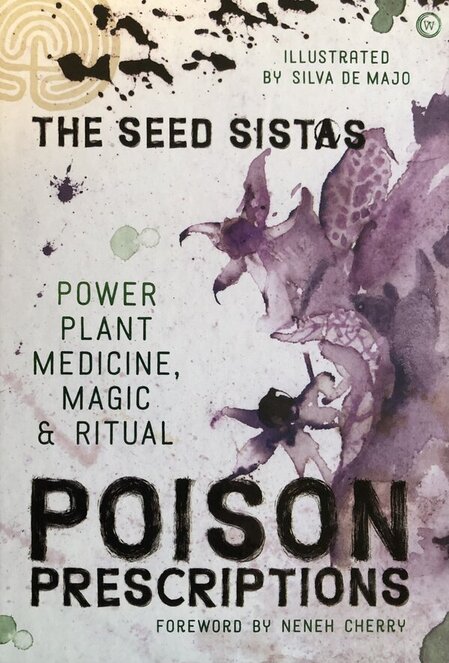“Poison Prescriptions” by the Seed Sistas

Priestesses of Cerridwen Elan and Alex review the new Seed Sistas’ book, “Poison Prescriptions – Power Plant Medicine, Magic and Ritual”, published last November, all about the infamous poisonous beauties often called “Witching herbs”.
In the season of the Swynwraig, this is a useful book for anyone following the Plant Path. Cerridwen would undoubtedly have had knowledge of these ‘witching herbs’ and therefore, “Poison Prescriptions” provides us with a window into the darker and more mysterious aspects of Cerridwen, the Swynwraig.
Elan writes:
“Poison Prescriptions: Power Plant Medicine, Magic and Ritual” is the second book by The Seed Sistas.
Their first book, “The Sensory Herbal Handbook”, clearly stated their intentions for an intuitive style of herbalism, where plants are given imagined personas and the reader is encouraged to access wisdom by slowly building up a meaningful relationship with the plants.
“Poison Prescriptions” follows the same style, but it is perhaps more revealing and honest about who the Seed Sistas are, and what makes them tick.
The Seed Sistas are Fiona Heckels and Kazz Goodweather, both medical herbalists who met each other during their training – it was clearly a perfect match of two like-minded souls.
They also describe themselves as eco-activists, speakers and modern plant folklorists; and, in the book, the Seed Sistas provide some intriguing background details of how they came to do this line of work – they are also self-proclaimed ravers, well-versed in festival culture (the singer, Neneh Cherry, has written the foreword to “Poison Prescriptions”), with an eccentric and refreshing view of the importance of taking medicine and magic out to the people, and providing the tools to access our native plants.
There is definitely something of the rebel inherent in their work and overall message.
“Poison Prescriptions” steps even further down the green path of plants than their first book, “Sensory Herbalism”. It takes the older, shadier routes into the wood. It is undoubtedly more ‘witchy’ in its spirit.
This is partly due to the choice of featured plants in this book – rather than attempting to provide an exhaustive overview of every British poison plant, they have chosen to concentrate on three significant plants – Henbane, Datura and Belladonna – and the book is all the stronger for this decision.
The Seed Sistas provide detailed information about each plant, including its key themes, history and mythology, as well as practical information about distribution, harvesting and use.
They do not shy away from the ‘darker’ elements of the poison plants, but they also include information about the healing elements of Henbane, Datura and Belladonna, which have often been disregarded or forgotten due to the plants’ reputation as ‘witching herbs’.
Interestingly, as a side-theme, “Poison Prescriptions” is laced with respect and honour for the historical wise women and, at a time when the witch is being rejuvenated, rehabilitated and pardoned (by parliaments), “Poison Prescriptions” feels as if it is part of a bigger movement, which is celebrating and appreciating the witch and all the power (plant power included), which goes with that image.
Alex writes:
I particularly liked the Seed Sistas approach to the witching herbs: these magnificent plants are often dismissed by herbalist practitioners, being potentially lethal even in low doses, while many magical practitioners tend to exalt only their psychotropic effects, especially when they’re administered in elaborate rituals of ceremonial magic.
The Seed Sistas instead adopt an approach characterized by both scientific accuracy and folk wisdom, resulting in a very enjoyable work that contributes to rendering the world of the so-called “power plants” definitely accessible.
They clearly explain in this book that these herbs are not only carriers of powerful active substances, that can find application in many fields of medicine (here Kazz and Fiona’s professional preparation, and the extent of their researches, are absolutely noteworthy), but they are also powerful Plant Spirits with which it is possible to work in a magical way, using our intuition and ability to connect on a subtle level with the plant (and using an extensive knowledge about how their poisons work and need to be physically handled!).
There are many suggestions in the book for simple ritual acts to deepen the connection with these powerful allies, with a strong emphasis on how working with these herbs implies not only a great respect for their power, but also the necessity of connecting with the land and the community in which one lives – growing these plants, making art and rituals with them, as collective acts of remembering and reclaiming the wisdom of the past (which saw a large use of these plants), as well as discovering what they can teach us about ourselves, now.
Henbane, Datura and Belladonna can be found all across the world, and, as my Sister previously said, reclaiming the relationship with them means not only bringing back from oblivion the heritage of the wise and cunning folks of the past, but also learning a different approach to the world regarding magic, healing, sex and death, all areas in which these Plant Spirits can facilitate a deep inner work.
Lifting the veil of fear that surrounds these plants means necessarily learning to relate to the land and the environment in a more natural and, I dare say, mature way, i.e. not trying to deny the “darker”, more dangerous aspects of Nature (and, as a reflection, of ourselves), but acknowledging that there is poison, in the world, and death; and it’s up to us whether we are crushed by fear, or learn how to live with the knowledge and lessons of the “shadow side of the world”.
As Paracelsus said, quoted in the first pages of the book, “In all things there is poison, and there is nothing without a poison. It depends only upon the dose whether a poison is poison or not”.
The Seed Sistas have thoroughly researched and experimented on themselves all said above, both physically and in personal inner work, putting together their competences as medical herbalists and witches. The culmination of their work is presented in the final part, which features two great recipes: their version of the infamous “Witches’ flying ointment”, and a fascinating “Passion potion”.
The first in particular has immediately raised my interest, as it is an oil infusion obtained with a year-long work, with detailed instructions about the lunar phases in which to gather specific herbs, the ritual work to do with them and the infused oil, while the lunations and seasons pass, and how to use the ointment in meditation, trance and dream work, and so on…
A year long concoction of witching herbs gathered in a precise ritual way: reminds you of anyone?
Impossible not to think of our beloved Witch Goddess and Her year-long brew made to obtain the three blessed drops! Needless to say: although not acknowledged, I strongly feel the influence of Cerridwen here!
To conclude, this is a book we highly recommend not only to those interested in witchcraft and poisonous plants, but to all who sincerely aim to develop their relationship with the land and all its dwellers.
“Poison Prescriptions” is available from the usual physical and online outlets and can also be ordered directly from the Seed Sistas at Poison Prescriptions – power plant magic, medicine and ritual | Seed Sistas
Elan Clark, Priestess of Cerridwen
West Lothian, Scotland

Instagram: @elan_and_the_hare
Elan is a scholar, writer and editor in the field of Celtic Studies. She has a PhD in Gaelic poetry and teaches university classes in Celtic culture and literature.
Alex, Priestess of Cerridwen

Alex La Malfa
Emilia Romagna, Italy
Instagram: @song_of_the_waves
Alex is a Priestess of Cerridwen from Italy. She has been on the path of paganism and Goddess spirituality for 20 years, and has a huge passion for herbs, crystals, painting, folk traditions and all works of reconnection with the land.